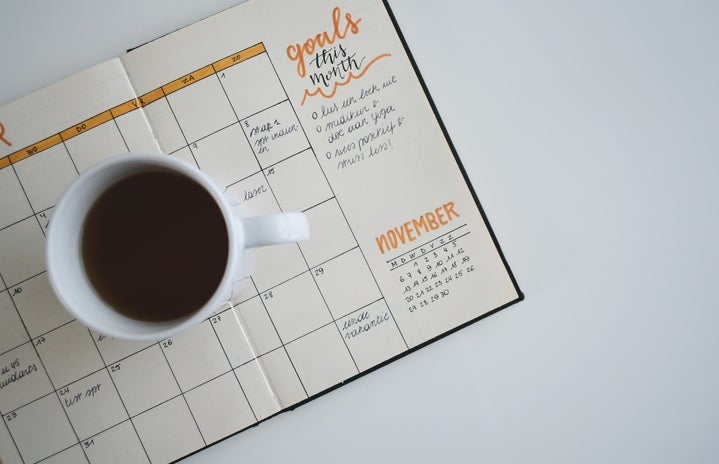For many college students, a successful semester means starting with the right planner. Keeping track of every assignment, quiz, social event, or shift for work can be overwhelming for anyone.
If you are anything like me, you probably worry about missing a deadline or being late for something daily. When using a planner effectively, you may find that you are getting more out of your day and feel more productive. In my three years of college, I learned how to make the most of my planner and create a schedule that makes sense for me. Here are some tips that might help you start the semester right by steering your planner in the right direction.
1. Start with Your Hard Day-to-Day Schedule
When I am in the middle of the semester, especially on Zoom, sometimes I feel like I am overbooking myself by trying to be in too many places at once. On the last page of my planner, where I have a few pages for notes, I write in my daily class and work schedules. These are things that are going to stay pretty consistent in my schedule week-to-week.
This technique may not work as well for people who have rotating work schedules that change week-to-week but by having a general layout of what my responsibilities for the week are, I am better able to picture where I can add in free time or pick up a shift or do anything else I may have to.
Within this section, do not include assignments or major events. This section should only include what your general week will entail. I find this section of my planner especially helpful if I am trying to schedule an appointment ahead of time. I either take a picture of my schedule or just take my planner with me and schedule appointments knowing when I need to commit time to class or work.

2. Add in Your Week
I like to choose one day of the week (for me, it is usually a Sunday) to write in all the assignments and deadlines I need to do for the coming week. I find that this is not too distant, and typically if I have a paper or an exam, the due date will not change by the time I write it in my planner.
I know some people who like to schedule their whole semester out in their planners when they get their syllabi during the first week. For me, though, this never ends up working out in my favor because odds are, especially during these unprecedented times, deadlines will change quite a bit before a big project is due. This method helps me keep up with knowing what is coming up in my week without getting too stressed about thinking too far ahead.
That said, if I look ahead a little and know I have a substantial project or paper due the following week I am writing in, I will put in a reminder at the top of the week or in Friday’s block to remind myself that something is due. I do this also in case I have free time during the week to think ahead and maybe get some work done for the bigger project).

3. Check Things Off
For me, nothing feels better than that sense of accomplishment you get when you complete a task. Even by crossing off a note in my planner that indicates I went to my Zoom class session or completed an assignment. I get the calming feeling of having completed a task.
Checking things off also helps me make sure I am completing assignments and prioritizing my work. If a task is crossed off, I know that it is done. A few people I know will do this by drawing a line through the written piece in their planner, but as someone who likes to be able to look back at when I did certain things or had things scheduled, I use a red pen to make a checkmark at the start of my assignment to indicate that I finished it.
4. Use Different Colors or Symbols.
Going along with using my red pen to check off completed assignments, I use a variety of different writing tools when conducting my planner to help me separate my classes, assignments, work shifts, and major deadlines.
For example, anything that has to do with class, I write in black pen. Most of my planner consists of writing in black pen because I am a full-time student. To separate classes from assignments, I highlight the times in the planner of my Zoom classes. This tactic helps separate the two in my mind and draw attention to my classes in my planner so that I do not forget them if I am working on something else before a class.
For work shifts, I use a blue pen so that it provides a color separation between schoolwork and professional work. Finally, I use my red pen again to signal any major assignments or deadlines. If I have a quiz, exam, paper, or important meeting, it gets written in red. It helps it stand out both in my planner and in my mind. Plus, if I am looking at my planner on Monday and see that I have something written in red on Friday, I can easily see it and remember that I have something important due on Friday.
5. Finally, Find a System that Works for You
At the end of the day, what matters is that you stay organized enough to set yourself up for success and do what feels right to you. Maybe it is a planner with specific lines and times written in, or maybe it is a planner with big open spaces that allows you to personally customize it by the date. You will figure out if there is a color system or guide that helps give you reminders throughout your week. The best thing to remember is to stick to the schedule and stick to your goals. A planner is a great tool to help you schedule out your semester and feel confident and productive. It matters how you use it as it will determine whether it helps you or not.




